A snowfall in the middle of summer. It happened, according to one legend, on the night of August 4-5, 358 A.D., when a blanket of fresh snow covered the Esquiline Hill in Rome. At the origin of the prodigy was adreamlike apparition of the Virgin, who asked a Roman patrician named John to build a church on the exact spot where the snow would fall. The next morning, the prodigy was fulfilled and was interpreted as a divine sign: Santa Maria Maggiore, now the oldest Marian basilica in the West, would rise there.
The tale has also found ample space in European artistic production, taking different forms depending on contexts, commissions and styles. Among the best-known representations is the one created by Tommaso di Cristoforo Fini, known as Masolino da Panicale (Panicale, 1383 - Florence, 1440/1447), preserved today at the National Museum of Capodimonte in Naples. The painting titled Foundation of the Church of Santa Maria Maggiore, part of a triptych commissioned by the Colonna family for the basilica of Santa Maria Maggiore itself, recounts the miraculous event: the pope, identified as Liberius, with a hoe in his hand traces the perimeter of the future church on the snowy mantle. Around him, a crowd observes the scene, while above Christ and Our Lady witness the miracle. Snowflakes are rendered by small white dots that invade the lower part of the composition, while round shapes appear in the sky that, according to a fringe theory, much discussed especially in the early days of the internet since it had some success on conspiracy sites, would be interpreted as flying saucers. In reality, they are simply snow-laden clouds, consistent with the iconography and the context of the religious narrative.
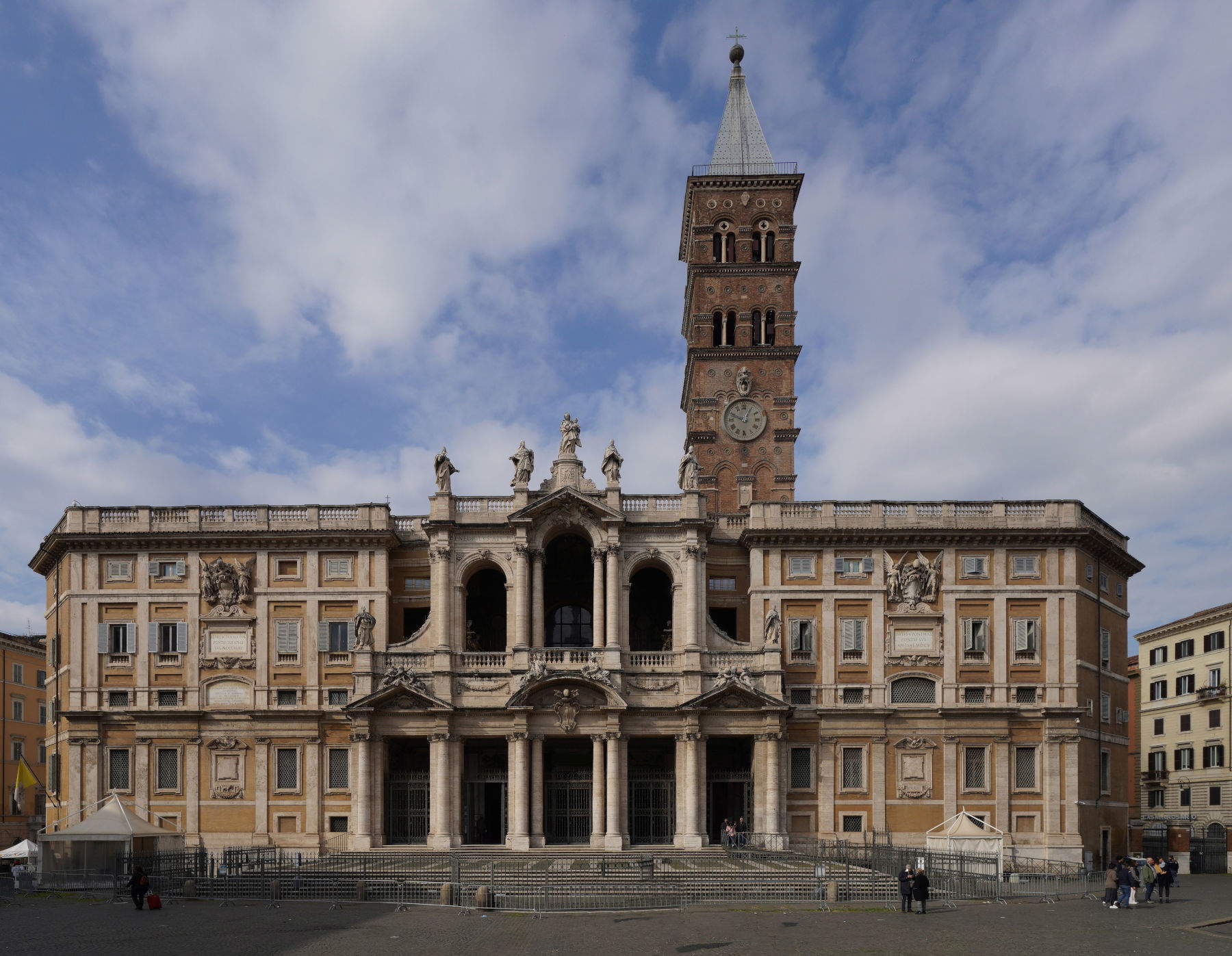
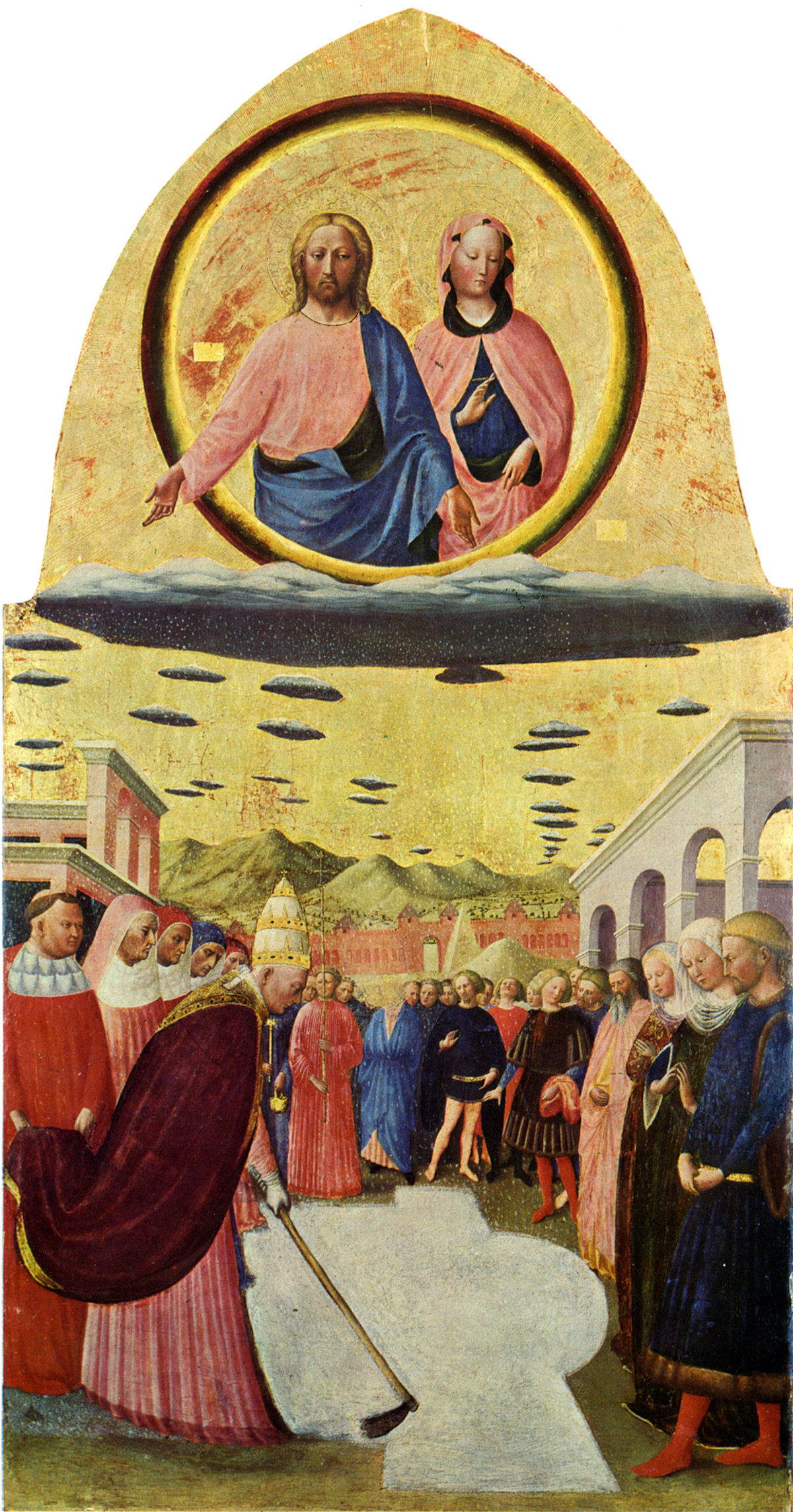
The triptych, painted on two sides and now dismembered, also saw the collaboration of Masaccio, who worked on one of the side compartments. Indeed, the collaboration between the two artists is considered fundamental to early 15th-century painting. Further evidence of the collaboration between the two artists can be found in the panel known as the Saint Anne Metterza, preserved in the Uffizi, which shows the Madonna and Child enthroned, surrounded by five angels and accompanied by Saint Anne, the Virgin’s mother figure and the protagonist of the work’s title. The realization was shared, but the stylistic differences are immediately perceptible: the figures entrusted to Masolino are less three-dimensional and more linear, while those painted by Masaccio are distinguished by a more solid and innovative volumetric rendering, a clear sign of his pictorial language already projected toward a new naturalism.
In 1424, the two artists were then involved in a new and more ambitious project. Felice Brancacci, a prominent member of the Florentine bourgeoisie, active in both the silk trade and city political life, commissioned the execution of a cycle of frescoes for the family chapel inside the church of Santa Maria del Carmine in Florence. According to Giorgio Vasari, Brancacci was particularly impressed by two frescoes, now lost, in the same church: one depicting St. Paul, attributed to Masaccio, and the other with St. Peter, executed by Masolino. His appreciation for both works therefore prompted him to entrust the two artists with the joint commission. The decorative undertaking probably began toward the end of 1424. The following year, during the summer of 1425, Masolino accepted a new commission that took him to Hungary, leaving the site in the hands of his younger colleague, who continued the work independently.
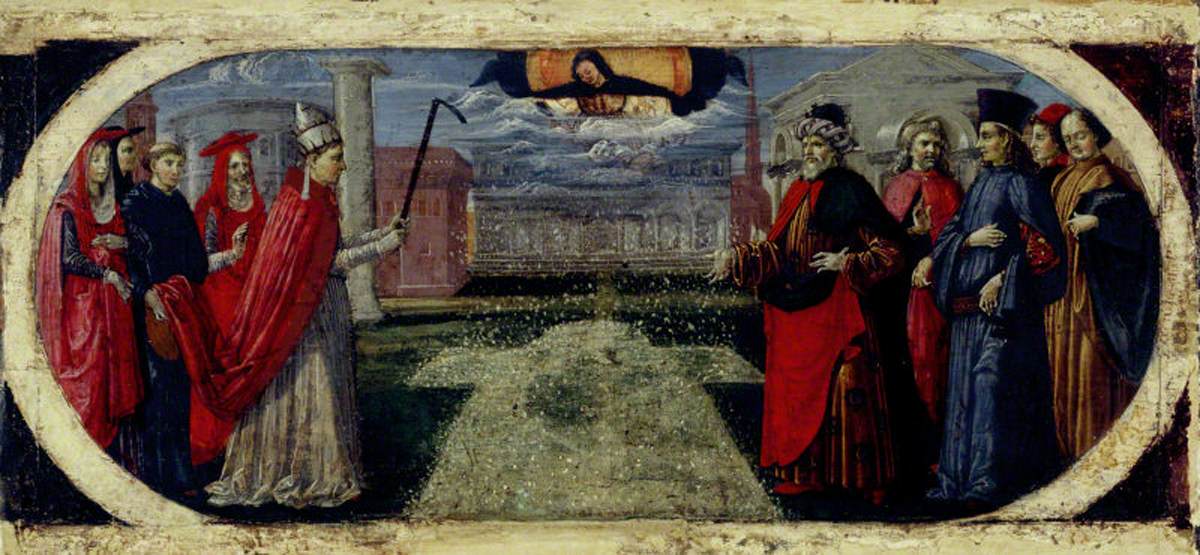
Another depiction of the miracle is found in the panel attributed to Pietro di Cristoforo Vannucci, known as il Perugino (Città della Pieve, c. 1448 - Fontignano, 1523). The panel, part of the predella of a lost altarpiece, is now preserved in Polesden Lacey, Surrey (UK), under the care of the National Trust. The scene, enclosed in an oval frame painted in faux marble, shows the Madonna appearing among clouds, from which snowflakes are falling. These are arranged to delineate the outline of the church on the lawn below, while the pope, once again with hoe in hand, prepares to begin construction. Beside him, a few figures observe the miracle, while classical buildings, porticoes and an honorary column are glimpsed in the background, suggesting an ideal representation of ancient Rome. The work, dating from the 1570s, was originally commissioned for the Pucci Chapel of the Basilica of the Santissima Annunziata in Florence. Following several collector’s passages, it came to the United Kingdom where it is preserved, like its twin depicting the Nativity of the Virgin, which is instead at the Walker Art Gallery in Liverpool and was formerly part of the same, lost polyptych.
A more Nordic and dramatic reading of the same legend, on the other hand, can be found in the panel painted in 1519 by Matthias Grünewald (Würzburg, c. 1480 - Halle, 1528), court painter to the archbishop of Mainz, also dedicated to theInstitution of the Basilica of Santa Maria Maggiore in Rome. The panel constitutes the right-hand compartment of the altar of Our Lady of the Snow in the collegiate church of Aschaffenburg, Germany, while the central panel, according to some speculation, is a depiction of the Madonna now housed in Stuppach, near Bad Mergentheim (in the land of Baden-Württemberg, on the southwestern side of Germany).
Currently, only the frame remains of the Renaissance altar complex; part of the pictorial decoration has been lost. In his work, Grünewald (who shortly before, 1512-1516, had created the monumental Issenheim Altar, now considered the main work of the Musée d’Unterlinden in Colmar, France) depicts the pope at the moment when, with a large retinue and a hoe in his hand, he symbolically lays the foundation stone of the building, surrounded by a snowy landscape. Above, the dreamlike scene of the vision occurs as the pontiff lies still in his bed. The entire episode unfolds along a simultaneous narrative, a technique dear to German painting of the period.
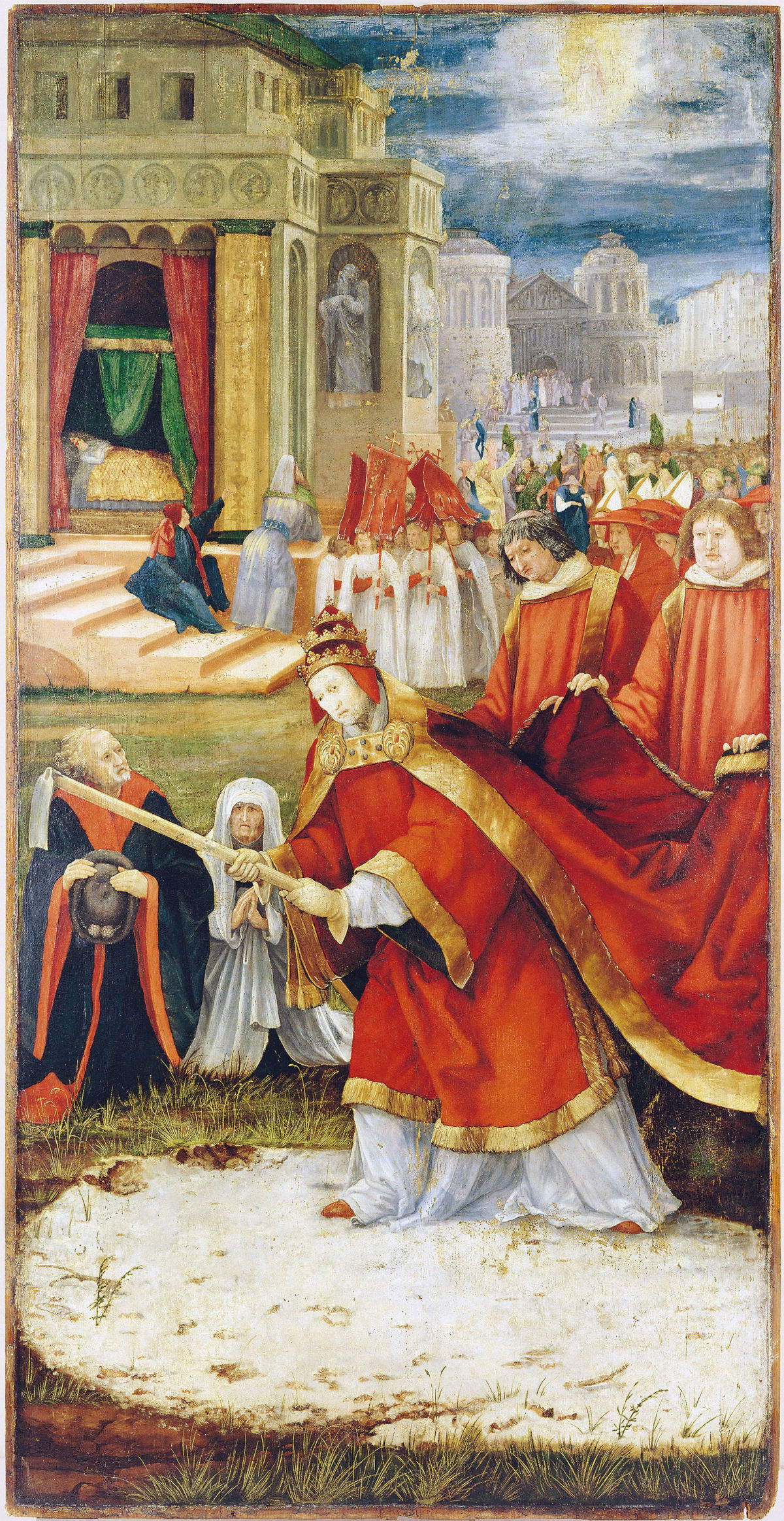
The altar had been commissioned by a canon named Heinrich Reitzmann, who had become acquainted with the cult of Our Lady of the Snow during a stay in Rome. The cult was explicitly based on the 4th-century legend and had spread outside Italy, eventually taking on autonomous liturgical forms in German circles. At a later stage, when the altar compartments were arranged to be closed, the back was also decorated. In that case, an unknown painter was commissioned to create theAdoration of the Magi, of which only the right half is preserved today.
The subject also attracted the interest of Jacopo Zucchi or Iacopo di maestro Pietro Zucca (Florence, c. 1541 - Rome, 1596), a pupil of Giorgio Vasari, active between Florence and Rome in the second half of the 16th century. His version of the Miracle of the Snow, made between 1578 and 1582, was originally placed right in the Basilica of Santa Maria Maggiore, near the altar of the Cradle in the nave. In 1770 it was moved to the Quirinal. The work falls within the strand of Mannerist painting, and takes up the same founding theme already elaborated by Masolino and Perugino, while maintaining a more saturated composition and palette, consistent with the taste of the time.
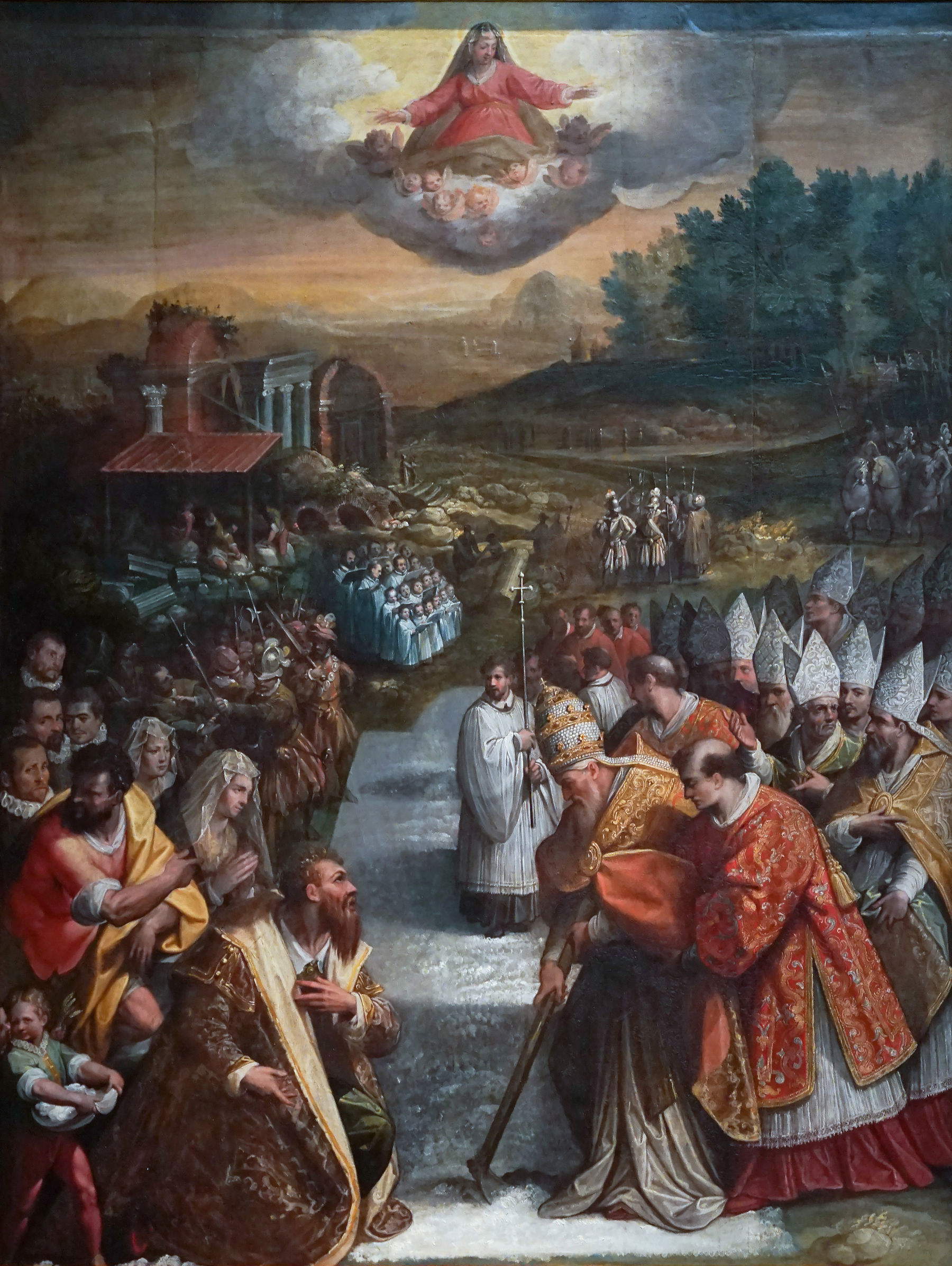
Although changing in styles and interpretations, Renaissance artistic representations have retained the same symbolic core: snow as a prodigious sign, the vision as a divine message, and finally the construction of the sacred place as a human response to a heavenly indication. The legend of the Madonna of the Snow has thus generated a long artistic tradition that has propagated for centuries, declining in different languages, materials and sensibilities, destined to mark the face of Rome.
Warning: the translation into English of the original Italian article was created using automatic tools. We undertake to review all articles, but we do not guarantee the total absence of inaccuracies in the translation due to the program. You can find the original by clicking on the ITA button. If you find any mistake,please contact us.